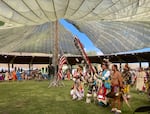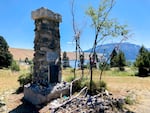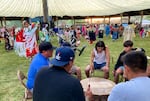
A drum circle provides the music for dancers at the Tamkaliks Celebration powwow on July 22, 2022. For more than 30 years, a band from the Nez Perce Tribe commemorates its return to the land following more than a century of exile.
Antonio Sierra / OPB
The hot summer day crept into evening by the time Fred Hill made his introduction.
“I want to welcome you here to the 30th annual Tamkaliks Celebration here in Wallowa, Oregon,” the master of ceremonies said. “We’ve anticipated this for quite some time.”
COVID-19 forced organizers to cancel the previous two powwows. Now, dancers were gathering outside the arbor, a circular structure with a parachute as a roof and three rows of bleachers for the spectators who assembled.
The drum circles started and voices rose in song. The Grand Entry had begun.
As the arbor filled with dozens of bodies in full regalia, people of all ages dressed in cloth and feathers of every color. The jingle of the metal on their regalia complimented the booming percussion that surrounded them.
The procession was led by men bearing the American flag and the Eagle Staff. To the Nez Perce, the eagle feather represents honor and good medicine.
Tamkaliks is an ongoing story about return. A return to celebration after two years of pandemic delays. A return to the homeland, and a hope for the future with even deeper roots.
Tamkaliks is the Nez Perce word for “where you can see the mountains.” In the long days of summer, the looming Wallowa Mountains to the south of the campsite were still visible from the arbor.
The Walwama were back home.
“— Celeste Whitewolf, Old Chief Joseph descendent and board member for Nez Perce Wallowa HomelandEarly on, I was skeptical about why would the white people want us here. They’re the ones that kicked us out. They’re the ones that chased us out. They’re the ones that killed our women and children. They’re the ones that prevented us from gathering our foods off the land and hunting and fishing. Why would they want us back here? So I was skeptical that first year.”
The very first Tamkaliks took place in a high school gym.
Taz Conner, a member of the Nez Perce Tribe and a U.S. Forest Service employee, began meeting with city of Wallowa community members like Jo Hallam and Terry and Nancy Crenshaw in the 1980s. The goal was to create an event that would welcome back the Nez Perce, more than a century after the U.S. government exiled them from the Wallowa Valley.
There are nine federally recognized American Indian tribes in Oregon, but the Nez Perce Tribe isn’t one of them. Despite its history in Eastern Oregon, the modern-day Nez Perce reservation is entirely contained in northern Idaho.
While the origins of the event are sometimes described as an economic development opportunity for the city of Wallowa, Taz’s niece, Bobbie Conner, said that was never the intent of tribal organizers.
“It wasn’t really an agreement to help boost tourism,” she said. “It wasn’t an agreement to help with economic development. It was an agreement that we needed to welcome home to this country, the Wallowa country, the people whose ancestors were sent out of this country in exile in 1877.”
The first celebration was held at Wallowa High School in 1991 and up until its start, Nancy Crenshaw was unsure how it would go.
“We didn’t know if anybody, any Natives, were going to come,” she said. “It was like, we’re sitting there and all of a sudden, people started coming and they have their regalia.”
Tamkaliks was successful enough in its first year to merit a second event, this time in an open field near town.
Like the Conners, Celeste Whitewolf was a descendant of the Nez Perce band that once lived in the far northeast of Oregon. She didn’t attend the inaugural Tamkaliks, and she proceeded with caution when she decided to attend in 1992.
She was acutely aware of the history that led to the original flight of the Nez Perce, but more than 100 years later, she was won over by the sincerity of the non-tribal organizers.
“I purposely at one point asked them, ‘Why are you guys doing this? Why you are you white people asking us to come back here?’” she said. “And it was really (heartening) to hear them say, ‘Because we want you here,’ which is really a total different vibe than back in 1877. They didn’t want us here in 1877.”

The grave of Old Chief Joseph north of Wallowa Lake. The Nez Perce Wallowa band leader refused to sign a treaty that would have forced them off their land in northeastern Oregon.
Antonio Sierra / OPB
“— Fred Hill, Tamkaliks master of ceremonies and Nez Perce Wallowa Homeland board member, on his connection to the War of 1877And (my ancestor) made it as far as Bear Paw, Montana. And in the fog, the melee of all the fighting against the cavalry … they were firing at each other. But somehow there was a mix up, and pretty soon the Nez Perce were shooting at each other in the fog, and he was accidentally killed by his own, which is tragic. But they were fighting for freedom.”
Archeological and DNA records show Indigenous people have lived on the Columbia River plateau for millennia.
When the Nimiipuu, later dubbed the Nez Perce by French fur traders, first encountered Euro Americans in the early 19th century, the event came on the far right end of their timeline.
At the Nez Perce Wallowa Homeland Visitor Center, the Wallowa tribal band’s extensive history is squeezed into a small room.
The Nez Perce once inhabited 14 million acres across modern-day Oregon, Washington and Idaho. Comprised of more than a dozen bands, the Nez Perce peoples shared language, religion and family, but each band had its own leader.
The Walwama — whose band, mountains and river were Anglicized to Wallowa — called the Wallowa Valley home. By the time the Nez Perce signed the Treaty of 1855 with the U.S. government, the Wallowa Band was led by Tiwitequis, also known as Old Chief Joseph.
Related: A tribal treaty: ‘This was the real story of the West’
The Treaty of 1855 shrunk the Nez Perce’s land considerably, but the new reservation maintained much of the Wallowa’s land in northeast Oregon.
The United States’ position changed once gold was discovered in the area. Settlers began encroaching on tribal land and the U.S. government returned to the issue in 1863 with a much harder line. Federal officials proposed further cutting the reservation boundaries to 10% of its original size, based around Lapwai, Idaho.
The Wallowa Band withheld its support for the 1863 treaty, but the government designated one of the other Nez Perce band leaders as the “Head Chief” and used his approval to justify ratifying the treaty.
The Wallowa stayed on their land until the issue came to a head in 1877. By then, Old Chief Joseph had died and his son, Hinmatowyalahqit, or Young Chief Joseph, took over as leader.
Under threat from the U.S. Army, the Wallowa agreed to move to Lapwai. But shortly after they began their journey, men from a different band killed several white settlers as retaliation for the murder of a Nez Perce man. Even though the Wallowa were not involved with the raids, their concession turned into a war.
The Wallowa traveled more than 1,000 miles across the Idaho and Montana territories, engaging in multiple battles and skirmishes along the way.
With many tribal leaders dead and his band suffering from cold and hunger, Chief Joseph surrendered following a battle at Bear Paw, Montana, on Oct. 5, 1877.
The U.S. government would never allow the Wallowa Band to make a permanent return to its homeland. Wallowa County was established in 1887, named after a people who were no longer welcome.
“— Bobbie Conner, tribal historian and Nez Perce Wallowa board member, on the aftermath of the War of 1877The unfortunate truth is that there are very few descendants who survived the war in complete families. Most of the people who came back after the war, they came home in fragments and remnants of families. And when the survivors of the wars came home, they made new families out of survivors.”
On the second day of this year’s Tamkaliks Celebration, Whitewolf stepped to the microphone and said history was often told from the men’s viewpoint.
She added that Wallowa women contributed to the War of 1877 by cooking, caregiving and setting up camp.
A group of about 20 women assembled at the arbor and took turns announcing who they were and their lineage. Some trace their ancestry all the way back to Chief Joseph and his family.
After the surrender at Bear Paw, the U.S. government forced the Wallowa to resettle in Kansas and Oklahoma. Living in squalid conditions, even more members of the band died.
After eight years, the Wallowa were allowed to return to the Northwest but not their homeland. Tribal members who hadn’t already settled in Lapwai moved to the Colville Reservation at Nespelem, Washington, and the Umatilla Reservation in Eastern Oregon.
Chief Joseph died on the Colville Reservation in 1904, but he never stopped lobbying for his band’s return to the Wallowa country.
In 1899, the Wallowa Chieftain newspaper reported on a speech Joseph gave in Enterprise, the seat of Wallowa County.
Joseph had traveled across the country to make the case that Wallowa County still belonged to his people and, in Enterprise, he reiterated his argument.
The Chieftain may have been named after Joseph, but it offered him no sympathy. The newspaper dismissed Joseph’s arguments, questioning why he was only asking for a few pieces of land rather than the whole county if the land truly belonged to his people.
“Nobody ever expects to hear of the government buying out whole towns and thickly populated communities to satisfy the whim of an Indian,” the article states near its conclusion.

Dancers get ready to enter the arbor ahead of grand entry at the Tamkaliks Celebration on July 22, 2022.
Antonio Sierra / OPB
“— Taz Conner, Tamkaliks founder, 1994It has fallen upon the shoulders of this generation to capture the history and, through cultural understanding, respect this land that we live in. We all came together at this historical location to extend our concerns for a better world by maintaining for future generations the knowledge that made this land a wonderful place to live.”
Taz Conner died in 1999, but his peers and successors continued the work of the Tamkaliks Celebration.
By the time Conner was buried in Wallowa Cemetery, the founders had formed a permanent organization, the Wallowa Band Nez Perce Trail Interpretive Center, and it had acquired property to hold the celebration.
In the years that followed, the organization – also known as Nez Perce Wallowa Homeland – expanded its property and set about improving it. The group built a kitchen and bathhouse for campers and a longhouse for religious and cultural ceremonies.
Today, the organization operates an interpretive center in Wallowa that’s staffed year-round by a small group of employees
Angela Bombaci was hired by Nez Perce Wallowa Homeland in 2017, after spending the previous 15 years away from her hometown.
She was born in Enterprise and graduated from Wallowa High School in 2003. She remembers taking the Tamkaliks Celebration for granted.
The common myth in the community was that Chief Joseph got along with the pioneers and the Wallowa wouldn’t have had to leave if it wasn’t for the Army. Local schools didn’t offer much more information, with history classes more focused on American Indian history in general rather than the tribe that lived on the city’s land up until a few generations ago.
Bombaci left Wallowa and moved to California, where she worked in the technology industry. When she decided to move back in 2017, she sought more meaningful work.
She found that work with Nez Perce Wallowa Homeland.
“It was a real homecoming for me, and I shared the affinity and the desire to be here,” she said.
Nez Perce Wallowa Homeland hired her as its program manager and she would eventually earn a promotion to executive director, the first in the nonprofit’s history. Over her tenure, Bombaci learned just how much the town had changed.
“You know how if you don’t look in the mirror for a week, you’re like, ‘Oh, I got a tan while I was out camping,’” she said. “It was really obvious to me how the culture was shifting here to be more inclusive, more welcoming. There was less of the cowboys versus Indians element.”
Bombaci left Nez Perce Wallowa Homeland last month after moving a couple of hours away to Walla Walla, Washington. But she was back for a few days to help organize Tamkaliks after its two-year pandemic hiatus.
With the event back, many organizers said turnout and enthusiasm felt higher than in previous events.
“— Tulhuulhulsuit, a Nez Perce leader who died in the Battle of Bear PawI belong to the land out of which I came.”
Fred Hill doesn’t remember the exact year he started attending Tamkaliks, but he estimates he’s been to half of them.
He first attended when the event hosted a dance in tribute to an elder he knew. He not only participates in the powwow each year, but also serves on the Nez Perce Wallowa Homeland board.
Taking a break between an afternoon and evening dance on the celebration’s second day, this July, Hill said he liked that the powwow wasn’t a high-profile event. Tamkaliks doesn’t bring in big-name dancers or drummers, but it has a specific cultural significance.
“It’s our children that we speak of all the time, it’s for them to have what our early elders had fought for,” he said. “They stood their ground, and we’re still standing our ground.”
Many organizers hope Tamkaliks can retain its tight-knight spirit in the future while still expanding its vision. Hill wants to see more tribal members participate in the organization effort and Bobbie Conner would like to see the homeland host Nez Perce language immersion programs for younger generations.
Nez Perce Wallowa Homeland operates independently from the Nez Perce tribal government, but the tribe is also investing in Wallowa County. In 2021, they bought a Methodist church in Wallowa as a move to reacquire property in the county. The day before Tamkaliks, the tribe held a ceremony with local businesses to celebrate a conservation easement the Nez Perce acquired along Wallowa Lake.
Before Tamkaliks, Conner remembered hearing stories about Nez Perce who would come back to the Wallowa country to hunt, fish or camp.
For others, their reconnection stories came much later.
“I also was present in 1997 or ‘98, when one of our relatives from the Nespelem Chief Joseph Band came here. And she wept,” Conner said. “Because this was the first time, many generations later, that she was seeing the country that her parents and their parents had talked about being lost to us. She saw the Wallowa Mountains, the peaks, the snow, the lush grasslands, the rivers running through this project. And she marveled at this landscape and said, ‘Now I know. Now I know, this is what they missed.’”

A drum circle provides the music for dancers at the Tamkaliks Celebration powwow on July 22, 2022.
Antonio Sierra / OPB